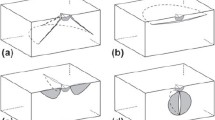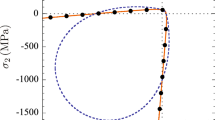Abstract
The microfracture patterns observed around point indentations in brittle solids are investigated. A description is first given of the stress field in an elastic half-space loaded normally at a point in its surface. This field is then used as a basis for analysing the crack geometry. A localized zone of irreversible deformation forms about the contact point, thereby removing a singularity in the elasticity solutions and providing nucleation centres for the ensuing microcracks. Generally, two main types of ‘vent’ cracks are observed to propagate from the deformation zone: median vents, formed during indenter loading, spread downward below the point of contact on planes of symmetry, and lateral vents, formed during unloading, spread sideways toward the specimen surface. Of these, the median vent is relatively well-behaved, and is amenable to standard fracture-mechanics analysis. From such an analysis we derive the means for predetermining, in principle, the depth of fracture damage under given point loading conditions. The significance of the results in relation to important practical applications, such as glass cutting and surface fragmentation processes, is discussed.
Similar content being viewed by others
References
A. Kelly, “Strong Solids” (Clarendon, Oxford, 1966).
D. Tabor, “Hardness of Metals” (Clarendon, Oxford, 1951).
M. T. Huber, Ann. Physik 14 (1904) 153.
M. V. Swain, Ph.D. Thesis, University of New South Wales, 1973.
B. R. Lawn and T. R. Wilshaw, “Fracture of Brittle Solids” (Cambridge University Press, Cambridge, in press), Ch. 3.
F. C. Frank and B. R. Lawn, Proc. Roy. Soc. Lond. A299 (1967) 291.
M. V. Swain and B. R. Lawn, Phys. Stat. Sol. 35 (1969) 909.
F. B. Langitan and B. R. Lawn, J. Appl. Phys. 41 (1970) 3357.
R. E. Hanneman and J. H. Westbrook, Phil. Mag. 18 (1968) 151.
S. M. Wiederhorn, J. Amer. Ceram. Soc. 52 (1969) 99.
D. J. Rowcliffe and G. E. Hollox, J. Mater. Sci. 6 (1971) 1261.
E. A. Almond and B. Roebuck, “Scanning Electron Microscopy: Systems and Applications” (Conference Proceedings, Institute of Physics, London, 1973) p. 106.
S. Palmqvist, Arch. Eisenhuttenwessen 33 (1962) 629.
T. R. Wilshaw, G. M. Crimes, K. Phillips, W. Swindlehurst and I. Freeman, unpublished work.
J. Boussinesq, “Application des Potentiels à l'Etude de l'Equilibre et du Mouvement des Solides Elastiques” (Gauthier-Villars, Paris, 1885), discussed in S. P. Timoshenko and J. N. Goodier, “Theory of Elasticity” (McGraw-Hill, New York, 1970) pp. 398–402.
Author information
Authors and Affiliations
Additional information
On study leave, from School of Physics, University of New South Wales, Kensington, New South Wales, Australia.
Rights and permissions
About this article
Cite this article
Lawn, B.R., Swain, M.V. Microfracture beneath point indentations in brittle solids. J Mater Sci 10, 113–122 (1975). https://doi.org/10.1007/BF00541038
Received:
Accepted:
Issue Date:
DOI: https://doi.org/10.1007/BF00541038




